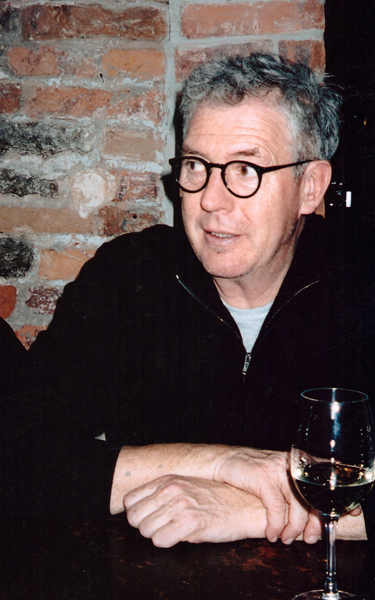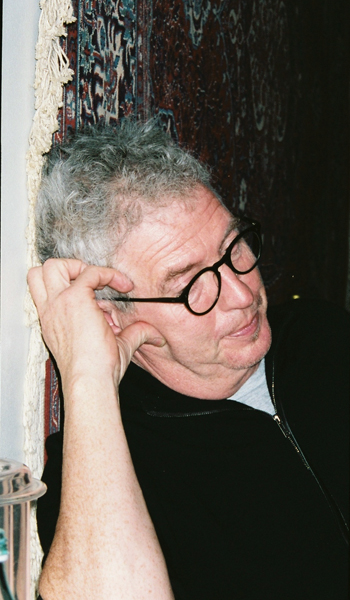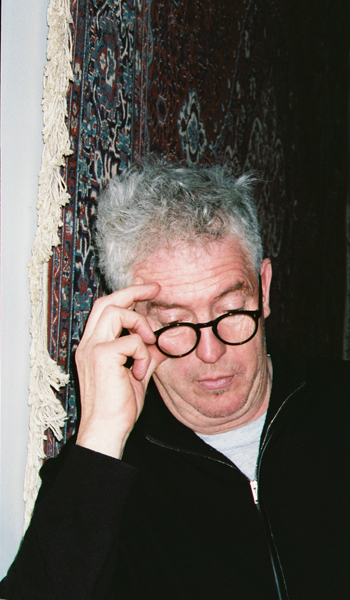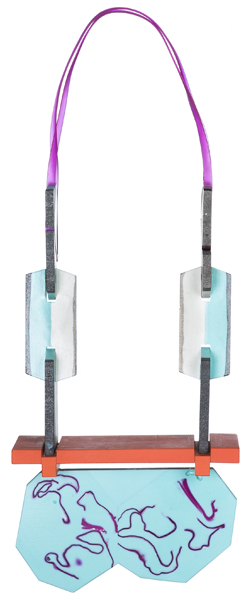![Portrait of Dr. Angelika Nollert, photo: Anna Seibel Portrait of Dr. Angelika Nollert, photo: Anna Seibel]()
In May 2014, Dr. Angelika Nollert succeeded Dr. Florian Hufnagl as the director of what is arguably the world’s largest design museum, the Die Neue Sammlung—The International Design Museum Munich, including its internationally renowned jewelry collection in the museum’s Danner Rotunda. While Dr. Nollert’s early background did not point toward contemporary art and design, her vast experience since has been steadily bringing her closer to her current position.
Dr. Nollert was born in Duisburg, Germany, in 1966. Initially trained in banking, she studied art history, archeology, and German literature at the University of Würzburg and the University of Münster. She received her PhD in 19th-century Netherlandish landscape painting from the University of Münster with a dissertation on the Dutch painter Barend Cornelis Koekkoek.
From 1997 to 2000, she was a curator at Portikus, an exhibition space for contemporary art in Frankfurt/Main, and in 2001 she became project manager of Documenta 11 in Kassel, Germany. Following five years as the project manager for visual arts at the Siemens Arts Program in Munich, she was the director at the Neues Museum, the State Museum for Art and Design in Nürnberg from 2007–2014.
Ursula Ilse-Neuman: Dr. Nollert, I would like to thank you on behalf of Art Jewelry Forum (AJF) for fitting this interview into your very busy schedule, especially after the particularly demanding activities of Munich Schmuck week. It was the first time that you have had such an active role during Schmuck. Can you comment on this experience?
Angelika Nollert: Yes, it is the first time that I have been directly involved in Munich, but in prior years I had already looked at the Sonderschau and other jewelry exhibitions in Munich and elsewhere. And it is fortunate that the subject of jewelry was always prominent in Nürnberg as well.
Have the Nürnberg jewelry activities been under your direct supervision, or were they mostly an offspring of the activities in Munich—given the fact that both institutions are closely affiliated?
Angelika Nollert: I have been familiar with jewelry at the Nürnberg Museum of Design as well as the Academy of Fine Arts (Akademie der Bildenden Künste). The Nürnberg Academy is a fine arts academy that I have been familiar with for many years since I came from a fine arts background. The Academy curriculum features silversmithing and jewelry; the noted conceptual jewelry artist Suska Mackert is now the professor of the fine arts/gold and silversmithing department. (Suska was previously the head of the jewelry department at the Gerrit Rietveld Academie, Amsterdam.) As a result, I have always associated jewelry with the fine arts as well as the applied arts.
I deliberately spent the last seven years at the Nürnberg Museum because it gave me the opportunity to work in both the fine and the applied arts. My academic background at the university was in art history, but I was also active in interdisciplinary fields.
JEWELRY COLLECTION
Do you view jewelry more as art, or as craft?
Angelika Nollert: Both. Author jewelry (Autorenschmuck) emerges from craft but it has to reach a different level in order to be elevated above craftsmanship. Whenever I look at a piece, I first ask when was it made and whether it is representative of its time. Does it have a context with its time or even is it critical of its time? How do the materials express the spirit of the time? Jewelry, in my opinion, should always present a discourse on the cultural situation of its time. One does not have to overinterpret everything, but there is a cultural, social, and political context. Some pieces, of course, express these aspects more distinctly than others. I am especially interested in materials and how they are used, because the materials relate to certain stylistic movements.
![Vera Siemund, necklace, 2007, and bangle, 2000, (hand)sawn steel and gold, embossed and hewn out, on permanent loan from the Danner-Foundation, Munich, courtesy Die Neue Sammlung - The International Design Museum, Munich, photo: A. Laurenzo Vera Siemund, necklace, 2007, and bangle, 2000, (hand)sawn steel and gold, embossed and hewn out, on permanent loan from the Danner-Foundation, Munich, courtesy Die Neue Sammlung - The International Design Museum, Munich, photo: A. Laurenzo]()
You just had your first big acquisition committee meeting—how is this committee run?
Angelika Nollert: It is held once a year. In general you can say that all museums have minimal purchasing budgets. You have to personally generate interest in the field and approach sources in the “marketplace.” We have a very privileged situation here at the Pinakothek. The Danner Stiftung does not have a fixed budget for the museum—the amount of money given varies from year to year. But I have to admit this is an amount other museums can only dream about—a wonderful support which allows us to make meaningful purchases. There is an entire committee, including a representative from the Danner Stiftung, as well as Otto Künzli, Karen Pontopiddan, myself. The membership is not a secret—it also includes the jeweler Robert Smit from the Netherlands, as well as Hans Stofer from the Royal College in London.
What are the criteria for accepting pieces into the collection?
Angelika Nollert: There are a host of considerations. A work has to have lasting value. It should still be vital in five years. It has to be of its time, which is true of all design. I am not interested in pieces dated 2015, but which could have been done in 1980. Very important is the discourse with the current period and its cultural context.
Another consideration is gaps in the collection, which for example does not include many representatives from South America.
![Sally Marsland, two brooches from the series Almost Black Brooches, 2000, dimensions variable, on permanent loan from the Danner-Foundation, Munich, photo: George Meister Sally Marsland, two brooches from the series Almost Black Brooches, 2000, dimensions variable, on permanent loan from the Danner-Foundation, Munich, photo: George Meister]()
What about new acquisitions into the collection? Do you anticipate any changes in your acquisition policy—will you concentrate on a particular era, country, or continent? Will you continue to concentrate on wearable jewelry, or will you also include videos and other conceptual works—such as Suska Mackert’s—that are about jewelry but not wearable?
Angelika Nollert: One has to be careful there. We already own about 1,000 objects in the jewelry collection—mostly wearable jewelry with a concentration on Europe. We own several purely conceptual pieces, like for example the texts about jewelry by Manfred Nisslmüller. Also some boxes that are purely conceptual and not wearable—but we don’t own very many. I think one has to explain those works through the history of contemporary jewelry. In the future, I would very much want to collect works such as those by Suska Mackert. Galerie Spektrum had a very intriguing exhibition of her work: it contained several works based on newspaper clippings—her Atlas, Ikonen, or Augen—that deploy several layers of meaning. I would really like to give Suska a solo show.
![Suska Mackert, [left] EOdG.W.Augen_0019 (Atlas), [right] EOdG.W.Augen_0047(Atlas), 2014, photograph/printed matter, 210 × 297 mm each, newspaper clipping FAZ Suska Mackert, [left] EOdG.W.Augen_0019 (Atlas), [right] EOdG.W.Augen_0047(Atlas), 2014, photograph/printed matter, 210 × 297 mm each, newspaper clipping FAZ]()
What does your committee concentrate on? Mainly established artists, or also emerging ones?
Angelika Nollert: For one, the focus is on contemporary works. But as in the past, we also consider historic pieces offered through private collections or foundations. For example, in the past, a necklace by Henri Van de Velde, Anni Albers, or Calder have been chosen. I just proposed Tattu de Carla’s concentric rings from the 1970s. These are rare pieces and I would like to acquire them when they appear on the market. Hermann Jünger, of course, I would immediately take additional pieces—but they are rare and the price is high. Calder is much higher, but luckily we have pieces by him already in the collection.
Our aim is to demonstrate the evolution of contemporary jewelry through the collection. But I want to emphasize that historic pieces cannot be collected in depth—just a few examples of important works with which to represent an artist, a style, an era—we have to get them when they are available.
Are you interested in computer designed and computer manufactured jewelry? Do you collect it?
Angelika Nollert: Not yet. But this is the exciting thing—where does the journey lead us? This is the question all the craftsmen working in any media will have to ask themselves–not just the jewelers. For example those exhibiting at the Handwerksmesse. There are very exciting developments such as 3-D printing—but you can’t just print out traditional forms, they need to be in a new formal language, in which the forms adequately express the Zeitgeist, not just new techniques.
In your opinion, do these objects still look too mass-produced while trying to masquerade as one-off forms of our time?
Angelika Nollert: Yes. I think we are still at the beginning of these developments. My main concern is what object do I want to create, and then what technique should be used to realize it. Especially for jewelry, the form and concept are most important, and I would not want to start with the technique.
Are you going to the Schmuck Sonderschau with the intention of buying works for the collection?
Angelika Nollert: The committee members and I go to the fair for this purpose, and everything is very openly discussed. Everybody has the right to propose pieces—that is the beauty of our collaboration. All ideas are on the table and discussed openly. Also, the aforementioned committee concentrates only on the jewelry aspects of the collection, which makes our meetings effective, enjoyable, and productive.
So there is no strong competition among the committee members since the discussions only revolve around jewelry. At similar acquisition meetings at MAD, we presented pieces from different media, and purchases in jewelry had to compete with purchases in other media such as ceramics, textiles, glass, etc.
Angelika Nollert: Of course, each member pushes their preferences, but overall it’s very amicable and oriented toward one common goal within the jewelry department.
JEWELRY EXHIBITIONS
What is your approach to exhibitions with regard to jewelry?
Angelika Nollert: I have always been interested in crossovers and I look for intersections in fine arts, design, architecture, and even theater (stage) design. The present retrospective of Anton Cepka’s jewelry at the Pinakothek der Moderne is a good example. Cepka is particularly interesting as an artist because his works are so flexible—they fit into a number of different visual arts categories. In addition to the jewelry, his models are highly interesting, as for example his tabernacles. It is especially intriguing that, having come from an Eastern bloc country, he was introduced to kinetic art as well as modern architecture as it was practiced in the West. This reflects my particular interest in observing the subtleties of his Eastern (bloc) and Western artistic sensibilities.
![Exhibition view, Anton Cepka—Kinetic Jewelry, 2015, courtesy Die Neue Sammlung - The International Design Museum, Munich, photo: A. Laurenzo Exhibition view, Anton Cepka—Kinetic Jewelry, 2015, courtesy Die Neue Sammlung - The International Design Museum, Munich, photo: A. Laurenzo]()
![Exhibition view, Anton Cepka—Kinetic Jewelry, 2015, courtesy Die Neue Sammlung - The International Design Museum, Munich, photo: A. Laurenzo Exhibition view, Anton Cepka—Kinetic Jewelry, 2015, courtesy Die Neue Sammlung - The International Design Museum, Munich, photo: A. Laurenzo]()
Turning to your famous jewelry collection, what are your future plans with regard to its presentation? Will you continue to show the pieces as individual works of art in the Danner Rotunda cases as they now have been newly conceived by Otto Künzli, or would you be willing to mix jewelry with other pieces in the collection? For example, certain eras or forms in design, photography, painting, or even with such exhibitions as your current one that deals with film and the cinema?
Angelika Nollert: I would like to continue to seek out crossovers by combining the jewelry with other art forms, but [as the director of the entire museum] I have to acknowledge certain limitations. For example, we already have a wonderful design collection that has been assembled in a chronological order, and we have plans to combine paintings and photography with design. It is a matter of how to display the works in an intelligent and meaningful way that makes sense for our visitors. At the moment, many ideas are being considered, but we have to take a broad approach and consider all the objects in the collection, including jewelry of course. Nothing is set in concrete yet.
I very much would like to present thematic exhibitions. They are not only more quickly realized, but lend themselves to establishing new dialogues that allow visitors to see familiar objects in a different light and with new perspectives. This can be accomplished in a classical, rather straightforward manner, for example a jewelry theme based according to countries, such as Czech or Scandinavian or American jewelry. Alternatively, organizing the pieces according to decades, a point of view that may not be terribly profound or innovative, but which can nevertheless establish important and stimulating visual and conceptual relationships.
In this regard, during my years in Nürnberg, I set up three specific thematic rooms, and we might do it at the Pinakothek in Munich as well. As an example, the theme of “East-West” relationships comes to mind. This would be an easy, pragmatic idea to realize for our museum: We have a very large collection of works from the former East Germany [DDR] that are perfect for this curating approach. Our intention would not be to criticize or make decisions about “good versus bad,” but to show the richness of creativity on both sides of the border.
In jewelry, an important center in the former East Germany is Burg Giebichenstein in Halle—we thought to make a special case for this school.
We might also consider comparisons between the Western world and Asia. Another important aspect of our collections is the wealth of excellent drawings and working models for jewelry. We should definitely show them in the Danner Rotunda, which has not been done so far. This would be a natural and a good first step in making changes to the jewelry display in the Danner Rotunda.
![Exhibition view, Danner Rotunda, as newly curated by Otto Künzli, 2014, courtesy Die Neue Sammlung – The International Design Museum Munich, photo: Rainer Viertlböck Exhibition view, Danner Rotunda, as newly curated by Otto Künzli, 2014, courtesy Die Neue Sammlung – The International Design Museum Munich, photo: Rainer Viertlböck]()
![Exhibition view, Danner Rotunda, as newly curated by Otto Künzli, 2014, courtesy Die Neue Sammlung – The International Design Museum Munich, photo: Rainer Viertlböck Exhibition view, Danner Rotunda, as newly curated by Otto Künzli, 2014, courtesy Die Neue Sammlung – The International Design Museum Munich, photo: Rainer Viertlböck]()
How do you plan to advance the appreciation and knowledge of contemporary jewelry at the Pinakothek, in addition to showing the permanent collection?
Angelika Nollert: So far, we remain with one big show in March—Cepka, this year—and another one under the staircase, each year with works representing one particular school or academy. This year it was recent works by students from the Hiko Misuno College in Tokyo.
So, for the time being, this plan will remain.
Angelika Nollert: For certain the museum’s major activities around Schmuck in March will remain. This is a platform that I always want to use. But in the future, I would also like to think about exhibitions dealing with different time periods, stylistic eras, or explorations of materials and techniques, as we discussed earlier, and to showcase them during March Schmuck week.
Also, during March week especially, one should further the exchanges with the experts in the field—since so many attend the events. I regretted that there were no panel discussions this year.
With regard to future jewelry exhibitions, we have to go over the collection very carefully—we have many strong pieces from many countries going back 100 years. But by no means should we rest on our laurels.
I also consider it important to show work created at respected centers of jewelry because so much of the creative output of these international institutions depends on the personalities of the artists/teachers leading them. For example, the Royal College of London is recognized as a major center for creativity, with professors and students from all over the world. Similarly, the Rietveld Academy, the Munich Academy, and Cranbrook Academy, to name just a very few, where there is an active interchange of ideas and approaches through the exchange of professors and students in what has become a truly globalized field.
Are you going to employ guest curators or consultants who are very knowledgeable about specific aspects of contemporary jewelry, or will you remain with your in-house curators for the collection and jewelry exhibitions?
Angelika Nollert: Collaborations with other institutions are very important for public institutions, within Germany and internationally. With this in mind, I find that guest curators from other institutions are wonderful. Otherwise, I am very interested in exhibition exchanges through which you enrich your knowledge and understanding of the field. It would be very interesting, for example, to make an exchange with the Museum of Arts and Design.
COLLABORATIONS—ART SCHOOLS
And this brings me to the theme of collaboration with art academies and art schools. One can show the work of students and their professors; I am even interested in creating a research center. This would be fantastic! We might be able to finance artists and other experts through stipends and allow them at the museum to create new works and hold workshops, for example. We would want to promote international exchanges to encourage collaboration and the stimulating exchange of ideas on various subjects and themes.
When it comes to the influence of leaders in the field, whether directors, curators, or professors, I am struck by the fact that there are now two women in charge of contemporary jewelry in Munich—you as the first female director at the Neue Sammlung, and Karen Pontopiddan, the first woman to lead the jewelry department at the Munich Academy to replace Otto Künzli, who has now retired. Do you think the attitude and approach to jewelry will be influenced by this change of gender at the helm? Will feminism play a larger role?
WOMEN IN JEWELRY
Angelika Nollert: I always think when women work together there is quite naturally a greater awareness of gender issues, an interest I readily acknowledge. It would be interesting to find out how many women jewelry designers there are in various collections, compared to male designers. I am in fact currently collecting statistics on our own collection and have also approached other institutions and academies. We are just at the very beginning of delving into the subject.
I feel that these statistics, although dry, might prove or disprove prejudices or preconceived notions. As to the reality, I believe that women might suggest more women artists to collect, which has been my experience to date. After all, it is human nature to deal more with one’s own gender.
AMERICAN JEWELRY
Forgive the blunt question, but what is your opinion of American jewelry? American jewelers, writers, and collectors have often been disappointed that so few Americans are accepted into the Schmuck Sonderschau. In addition, there are not very many Americans in your collection.
Angelika Nollert: Yes, and we will try to remedy this. We will have Thomas Gentille’s solo exhibition in 2016, but he is just one person and his style has always been well received and very acceptable to the European audience. We also have pieces by Sam Kramer, Art Smith, Margaret de Patta, Arline Fisch, and Jamie Bennett, for example. After hearing Toni Greenbaum’s lecture here at the Pinakothek, we realized there are many other American jewelers to consider. I was a bit disappointed that the Sunday lecture elicited so few questions. The lecture was very interesting for our audience, although I would have liked to have been given some insight into the differences between jewelry on the East and West coasts of America.
I could support acquiring more work by Americans because American culture continues to exert a strong and broad influence on Europe. In this regard, given our restricted funds, I would always begin with acquiring contemporary pieces and then go back in time. But we have to get funds for American jewelry. I would also like to exhibit works that represent the interactions and interrelationships between European and American jewelry.
A strong feature in American studio jewelry is the narrative approach, which has historically been achieved through the collage/assemblage technique and the use of found objects. The appeal of these easily procured, nonprecious objects was often in the stories they told through visual and other nonverbal associations. The reason for this approach in American studio jewelry may be the lack of the long and strong goldsmithing tradition that exists in Germany and other European countries. You could fill some gaps in your collection with such pieces because they are so important for American studio jewelry.
Angelika Nollert: I agree that this is certainly an aspect to which we should give consideration and thought.
Since you are coming from the fine arts—could you interest “fine art” collectors in studio jewelry?
Angelika Nollert: Not that much. Most collectors are already intensely focused on their areas. The collecting activities in the fine arts are already diversified through paintings, sculpture, film, videos, and graphics. Since there are these preferences in these fields, jewelry will concentrate primarily on its own devoted collectors and not necessarily gain new converts from other art forms. However, many collectors I know in the fine arts do have an affinity for design, and many painters and sculptors themselves also collect design. But I am more optimistic about increasing the general public’s interest in contemporary art jewelry. Ultimately, I want to get all these visual arts branches together to become enthusiastic about each other’s work, of course including jewelry artists.
SCHMUCK WEEK
Do you think that the events at Schmuck week will grow even larger? There is some criticism that there are too many events.
Angelika Nollert: The week is naturally overweight. I personally find the more choices, the better—you don’t have to go to everything. It’s like an opera program—I choose what I want to see. And, for that reason, I would never complain that there are too many events.
Coming back briefly to collaborations, I want to stress again the unique collaboration with the Danner Stiftung that makes working with contemporary jewelry in Munich so exciting. The Danner Stiftung has always been particularly supportive of jewelry.
Another point I want to stress is the city of Munich itself as being uniquely positioned as the number one jewelry town. For example, I find it interesting that you are personally attending Schmuck each year.
Well, I grew up in Garmisch-Partenkirchen, not far from Munich, but I would go to Schmuck even if I were not from around Munich.
Angelika Nollert: That’s really great!
Coming back once more to Munich as a center for contemporary jewelry activities—the city has had a long and impressive jewelry history. The Handwerksmesse was founded in 1949. It was during a very important time for Germany to establish organizations to put forth new design and craft. In 1959, the first Schmuck exhibition took place, under the talented and enterprising Herbert Hoffmann. This information must continue to be disseminated. Munich’s reputation as a jewelry center also owes a great deal to Hermann Jünger’s long-time tenure here at the Munich Academy, followed by Otto Künzli. Dr. Hufnagl also played a big part, who together with Otto Künzli furthered jewelry at the Pinakothek and founded the Danner Rotunda. There were always specific moments where these personalities played a key role in furthering the field in Munich.
Finally, I would like to repeat: Since we have this huge collection, I would like to pursue the idea of inaugurating a research center.
We are coming to the end of the hour we set aside for our conversation. Is there something you would like to add or state again?
Angelika Nollert: What I find particularly challenging and interesting is to have one’s dreams and align them with the reality of the means with which to fulfill them. There are always many ideas and when you are able to realize them, or at least some of them, it makes you truly happy. In general, what makes me particularly happy about my directorship at the Pinakothek der Moderne is its wonderful jewelry collection. [says this with a big smile]
I realized your enthusiasm in the first few minutes of going through the Cepka exhibition—genuine, unfettered delight. I am sure you will be a strong advocate for the field, and the museum, rather all of us in the field, are fortunate to have you.
Thank you for this interview and until next year.
![Die Neue Sammlung, München, Design Vision, entrance wall, courtesy Die Neue Sammlung - The International Design Museum, Munich, photo: Rainer Viertlböck Die Neue Sammlung, München, Design Vision, entrance wall, courtesy Die Neue Sammlung - The International Design Museum, Munich, photo: Rainer Viertlböck]()

































































































![Suska Mackert, [left] EOdG.W.Augen_0019 (Atlas), [right] EOdG.W.Augen_0047(Atlas), 2014, photograph/printed matter, 210 × 297 mm each, newspaper clipping FAZ Suska Mackert, [left] EOdG.W.Augen_0019 (Atlas), [right] EOdG.W.Augen_0047(Atlas), 2014, photograph/printed matter, 210 × 297 mm each, newspaper clipping FAZ](http://live-art-jewelry-forum-d7.pantheon.io/sites/default/files/itw_uneuman_anollert_4a_4b_600x800px.jpg)













 Hair as a component of jewelry reached the height of its popularity in 1861, after Queen Victoria’s husband, Prince Albert, passed away. She mourned his death until the day she died, and even attempted to communicate with him through séances. At least eight pieces of jewelry were commissioned by Victoria that incorporated Albert’s hair. Victoria’s extended display of mourning launched the mid-Victorian or Grand Period, and set the stage for many pieces of art, clothing, and jewelry through about 1880.
Hair as a component of jewelry reached the height of its popularity in 1861, after Queen Victoria’s husband, Prince Albert, passed away. She mourned his death until the day she died, and even attempted to communicate with him through séances. At least eight pieces of jewelry were commissioned by Victoria that incorporated Albert’s hair. Victoria’s extended display of mourning launched the mid-Victorian or Grand Period, and set the stage for many pieces of art, clothing, and jewelry through about 1880.


